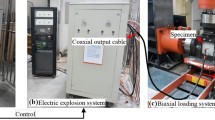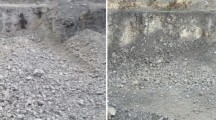Abstract
From blasting to downstream, processes are linked through the continuous reduction of the size of the rock. The effect of blasting is traditionally limited to fragmentation, although effects on crushing and grinding are also recognized and examined in the paper. Fragmentation prediction methods are reviewed to identify issues that need to be addressed in engineering models to improve the accuracy of the predictions. Blastability and energy partition during the blast are key areas for improvement. Damage to the rock, in the form of microcracks, is discussed using experimental findings as well as computer calculations of damage. Experimental results have shown that grindability is affected by energy consumption, which is simplified by the powder factor and by the powder distribution in the blast. Damage calculations show that powder distribution as well as energy partition are important, while the geometry of the blast, borehole pressure, delay time and the complicated stress-wave interaction during the blast play a significant role. To derive a relationship between blasting and milling, analysis of field data, considering lithology, fracture network, detailed blasting parameters and mill performance are needed.






















Similar content being viewed by others
References
Adebayo B, Bello WA (2014) Discontinuities effect on drilling condition and performance of selected rocks in Nigeria. Int J Min Sci Technol 24(5):603–608
Autodyn A (2009) Interactive non-linear dynamic analysis software, version 12, user’s manual. SAS IP Inc., Canonburg
Bergmann OR, Wu FC, Edl JW (1974) Model rock blasting measures effect of delays and hole patterns on rock fragmentation: 8F, 1T, 20R. Engn. Min. J. V175, N6, June, 1974, P124–127. In: International journal of rock mechanics and mining sciences & geomechanics abstracts, vol 11, no. 11. Pergamon, p A233
Berry TF, Bruce RW (1966) A simple method of determining the grindability of ores. Can Min J 87:63–65
Blair DP (2010) Limitations of electronic delays for the control of blast vibration and fragmentation. In: Proceedings of the 9th international symposium on rock fragmentation by blasting, p 171
Brannon RM, Leelavanichkul S (2009) Survey of four damage models for concrete. Sandia Natl Lab 32(1):1–80
Caceres J, Katsabanis P, Pelley C, Kelebek S (2006) Maximizing NPV by Blasting. In: Conference proceedings. 8th international symposium on rock fragmentation by blasting, Santiago, Chile, pp 246–254
Cunningham C (1983) The Kuz–Ram Model for production of fragmentation from blasting. In: Proc. 1st Symp. on Rock Fragmentation by Blasting, Lulea
Cunningham CVB (1987) Fragmentation estimations and the Kuz–Ram model-four years on. In: Proc. 2nd int. symp. on rock fragmentation by blasting, pp 475–487
Cunningham CVB (2005) The Kuz–Ram fragmentation model-20 years on. In: Brighton conference proceedings, pp 201–210
Davis LL, Hill LG (2002) ANFO cylinder tests. In: AIP conference proceedings, vol 620, no. 1, pp 165–168
Dobratz BM, Crawford PC (1985) LLNL explosives handbook properties of chemical explosives and explosive simulants—LLNL University of California. Livermore, California–(UCRL–52997, 1985)
Esen S (2013) Fragmentation modelling and the effects of ROM fragmentation on comminution circuits. In: 23rd international mining congress & exhibition of Turkey, pp 252–260
Faramarzi F, Mansouri H, Farsangi ME (2013) A rock engineering systems based model to predict rock fragmentation by blasting. Int J Rock Mech Min Sci 60:82–94
Fried LE (1996) CHEETAH 1.39 user’s manual. Lawrence Livermore National Laboratory, Livermore
Grundstrom C, Kanchibotla S, Jankovich A, Thornton D, Pacific DDNA (2001) Blast fragmentation for maximising the sag mill throughput at Porgera Gold Mine. In: Proceedings of the annual conference on explosives and blasting technique, vol 1, pp 383–400
Hikita DH (2008) The influence of blasting on Kemess hypogene ore milling. M.Sc. thesis. Queen’s University at Kingston
Hudson JA, Harrison JP (2000) Engineering rock mechanics: an introduction to the principles. Elsevier, Oxford
Johansson D, Ouchterlony F (2013) Shock wave interactions in rock blasting: the use of short delays to improve fragmentation in model-scale. Rock Mech Rock Eng 46(1):1–18
Junkin WR, Ben-Awuah E, Fava L (2019) Incorporating DFN analysis in rock engineering systems blast fragmentation models. In: 53rd US rock mechanics/geomechanics symposium. American Rock Mechanics Association
Katsabanis PD, Gregersen S, Kunzel G, Pollanen M, Pelley C, Kelebek S (2005) Effects of blasting on damage and grindability of impacted rock. CIM Bull 1091:91
Katsabanis PD, Kim S (2011) Effect of blasting on impact breakage of the resulting fragments—results from small scale tests. Fragblast Int J Blast Fragment 5(2):87–108
Katsabanis PD, Omidi O (2015) The effect of the delay time on fragmentation distribution through small-and medium-scale testing and analysis. In: Proceedings of 11th international symposium on rock fragmentation by blasting (Fragblast 11), Sydney, Australia, pp 24–26
Katsabanis P, Omidi O, Rielo O, Ross P (2014) Examination of timing requirements for optimization of fragmentation using small scale grout samples. Blast Fragment 8(1):35–53
Katsabanis PD, Tawadrous A, Braun C, Kennedy C (2006) Timing effects on the fragmentation of small scale blocks of granodiorite. Fragblast 10(1–2):83–93
Kemeny JM, Kaunda RB, Streeter D, BoBo T (2003) Effect of blasting on the strength of rock fragments. In: Proceedings of the twenty-ninth conference on explosives and blasting technique, pp 381–390
Kim S (2010) An experimental investigation on the effect of blasting on impact breakage of rocks. M.Sc. thesis. Queen’s University at Kingston
Khorzoughi MB, Hall R, Apel D (2018) Rock fracture density characterization using measurement while drilling (MWD) techniques. Int J Min Sci Technol 28(6):859–864
Kunzel G (2003) Study on blast damage development in small blocks and the effects on subsequent comminution. M.Sc. Thesis. Department of Applied Earth Sciences. TU Delft
La Rosa DM, Thornton DM, Wortley M (2009) U.S. Patent No. 7,490,507. Washington, DC: U.S. Patent and Trademark Office
Lilly PA (1986) An empirical method of assessing rock mass blastability. In: Proc. of large open pit mine conference, The Aus. Inst. of mining and metallurgy, pp 89–92
Latham JP, Lu P (1999) Development of an assessment system for the blastability of rock masses. Int J Rock Mech Min Sci 36(1):41–55
Michaux S, Djordjevic N (2005) Influence of explosive energy on the strength of the rock fragments and SAG mill throughput. Miner Eng 18(4):439–448
Morin MA, Ficarazzo F (2006) Monte Carlo simulation as a tool to predict blasting fragmentation based on the Kuz–Ram model. Comput Geosci 32(3):352–359
Napier-Munn et al (1996) Mineral comminution circuits. In: JKMRC monograph series in mining and mineral processing, JKMRC
Olsson M, Nie S, Bergqvist I, Ouchterlony F (2002) What causes cracks in rock blasting? Fragblast 6(2):221–233
Rai P, Schunnesson H, Lindqvist PA, Kumar U (2016) Measurement-while-drilling technique and its scope in design and prediction of rock blasting. Int J Min Sci Technol 26(4):711–719
Sanchidrián JA, Ouchterlony F (2017) A distribution-free description of fragmentation by blasting based on dimensional analysis. Rock Mech Rock Eng 50(4):781–806
Xie LX, Lu WB, Zhang QB, Jiang QH, Chen M, Zhao J (2017) Analysis of damage mechanisms and optimization of cut blasting design under high in-situ stresses. Tunn Undergr Sp Technol 66:19–33
Author information
Authors and Affiliations
Corresponding author
Ethics declarations
Conflict of interest
The author declares that he has no conflict of interest.
Additional information
Publisher's Note
Springer Nature remains neutral with regard to jurisdictional claims in published maps and institutional affiliations.
Rights and permissions
About this article
Cite this article
Katsabanis, P.D. Analysis of the Effects of Blasting on Comminution Using Experimental Results and Numerical Modelling. Rock Mech Rock Eng 53, 3093–3109 (2020). https://doi.org/10.1007/s00603-020-02093-4
Received:
Accepted:
Published:
Issue Date:
DOI: https://doi.org/10.1007/s00603-020-02093-4




